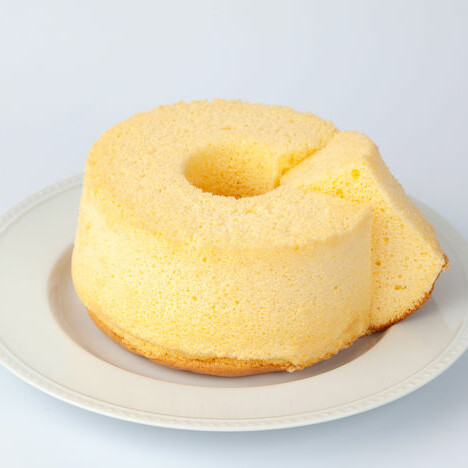
Chiffon Cake
What is Chiffon Cake?
A chiffon cake is a sweet baked good which combines a batter with a foam-type (sponge) cake. This type of cakes combine the richness of batter cakes such as high content of liquid whole eggs, fat and granulated sugar and the lightness and delicacy of angel food or sponge cakes.¹
- It is unusually tender and moist with superior keeping quality.
- These cakes are well known for their tall structure, light, soft and tender, springy texture.
Origin
Chiffon cakes were initially marketed in 1948, making it the newest baked good in over 100 years of baking. Harry Baker, a California insurance salesman and a home baker, had been secretly making cakes using this new method in his home for 20 years. In 1947, General Mills acquired Mr. Baker’s recipe and preparation process.²
How it is made
A chiffon cake should be light and fluffy with an open, “chiffon” grain, and a delicate flavor. In chiffon cakes, the batter is aerated by whipping high amounts of whole eggs, often enriched with extra egg yolks, into a light and fluffy foam. Small amounts of melted butter or vegetable oil are often incorporated into the aerated batter to produce a more tender cake structure.
Formulation for a traditional vanilla chiffon cake
| Ingredient | Baker’s % (based on flour weight) |
| 1st stage (dry ingredients) | |
|
Cake flour (short patent flour from soft wheat)* |
100.0 |
| Granulated sugar (50%) | 60.0–80.0 |
| Baking powder | 4.0–5.0 |
| Salt | 2.0–2.5 |
| 2nd stage (liquids) | |
| Vegetable oil | 50.0–60.0 |
| Egg yolks | 50.0–60.0 |
| Water | 55.0–65.0 |
| Vanilla extract | 2.0–5.0 |
| 3rd stage (foaming) | |
| Egg whites | 100.0–115.0 |
| Cream of tartar | 0.3–0.6 |
| Granulated sugar (50%) | 60.0–80.0 |
Processing
- Ingredients scaling
- Mixing: The mixing procedure and order of ingredient addition is extremely important in the production of chiffon cakes. Two separate mixing bowls or mixers must be used, one for mixing the solids and liquids (first and second stages), and the other for whipping the egg whites (3rd or foaming stage).³
-
- Into a mixer bowl, sift dry ingredients including 100% of flour, baking powder, salt, more than 50% of the sugar, and, if any, powdered flavoring.
- Combine the liquids, and incorporate into dry ingredients. Mix until batter is smooth with no lumps.
- Degrease equipment when working with only one mixing bowl. Whip egg whites, cream of tartar, and remaining sugar until the formation of a stiff yet not dry peak, firmer than that for angel food. Target specific gravity is 0.175–0.250.³
- Add batter mixture in a steady stream to the beaten egg whites as fast as the whites can accept it. Mix only enough to thoroughly blend the two together.
- Reversing this sequence (if folding the beaten egg whites into the batter) requires excessive mixing and could result in less volume. Final specific gravity is 0.30–0.50.³
- Depositing
- Baking: Baking times and temperatures vary with the scaling/deposited weight and size of the pan. Baking temperatures are typically 177–204°C (350–400°F), with a bake time of 45–55 minutes for large tube pan and 20–30 minutes for small tube pans. The cake is done when the surface springs back from a light finger impression.
- Cooling: Invert immediately when removed from the oven and let stand inverted until cool.
- Depanning: Remove from the pan when the cake is at room temperature.
- Slicing
- Packaging or serving
Application
- Cake flour can be replaced by a mixture of all-purpose flour and starch for protein dilution.
- Flour should have a protein content of 4.7–5.0%. A specialty flour that has been air separated, or turbo milled, is used almost exclusively in light angel and chiffon type cakes.
- Water in the 2nd stage can be replaced by whole milk. Milk solids and water content must be adjusted properly for optimum results.
- Egg yolks of good quality are important in chiffon cakes because of their contribution to color, flavor and emulsifying action which comes from the lecithin in the yolks.
- Oil functions as a tenderizer. A high grade liquid vegetable oil such as the type used in salad dressings is essential. Melted butter or plastic fats (hydrogenated shortening) will not perform well.
References
- Finnie, S., and Atwell, W.A. “Products from Soft Wheat Flour.” Wheat Flour, 2nd edition, AACC International, Inc., 2016, pp. 111–129.
- Olver, Lynne. “Chiffon Cake.” The Food Timeline: Cake History Notes. N.p., (2015).
- The Culinary Institute of America. “Quick Bread and Cakes.” Baking and Pastry: Mastering the Art and Craft, 3rd edition, John Wiley & Sons, Inc., 2016, pp. 265–316.

